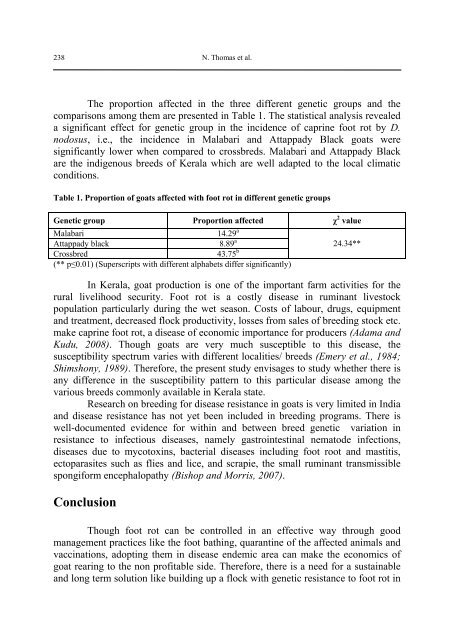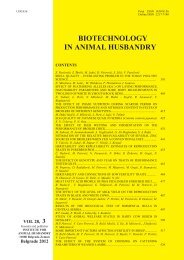Biotechnology in Animal Husbandry - Institut za Stočarstvo
Biotechnology in Animal Husbandry - Institut za Stočarstvo
Biotechnology in Animal Husbandry - Institut za Stočarstvo
You also want an ePaper? Increase the reach of your titles
YUMPU automatically turns print PDFs into web optimized ePapers that Google loves.
238<br />
N. Thomas et al.<br />
The proportion affected <strong>in</strong> the three different genetic groups and the<br />
comparisons among them are presented <strong>in</strong> Table 1. The statistical analysis revealed<br />
a significant effect for genetic group <strong>in</strong> the <strong>in</strong>cidence of capr<strong>in</strong>e foot rot by D.<br />
nodosus, i.e., the <strong>in</strong>cidence <strong>in</strong> Malabari and Attappady Black goats were<br />
significantly lower when compared to crossbreds. Malabari and Attappady Black<br />
are the <strong>in</strong>digenous breeds of Kerala which are well adapted to the local climatic<br />
conditions.<br />
Table 1. Proportion of goats affected with foot rot <strong>in</strong> different genetic groups<br />
Genetic group Proportion affected χ 2 value<br />
Malabari 14.29 a<br />
Attappady black 8.89 a<br />
Crossbred 43.75 b<br />
24.34**<br />
(** p≤0.01) (Superscripts with different alphabets differ significantly)<br />
In Kerala, goat production is one of the important farm activities for the<br />
rural livelihood security. Foot rot is a costly disease <strong>in</strong> rum<strong>in</strong>ant livestock<br />
population particularly dur<strong>in</strong>g the wet season. Costs of labour, drugs, equipment<br />
and treatment, decreased flock productivity, losses from sales of breed<strong>in</strong>g stock etc.<br />
make capr<strong>in</strong>e foot rot, a disease of economic importance for producers (Adama and<br />
Kudu, 2008). Though goats are very much susceptible to this disease, the<br />
susceptibility spectrum varies with different localities/ breeds (Emery et al., 1984;<br />
Shimshony, 1989). Therefore, the present study envisages to study whether there is<br />
any difference <strong>in</strong> the susceptibility pattern to this particular disease among the<br />
various breeds commonly available <strong>in</strong> Kerala state.<br />
Research on breed<strong>in</strong>g for disease resistance <strong>in</strong> goats is very limited <strong>in</strong> India<br />
and disease resistance has not yet been <strong>in</strong>cluded <strong>in</strong> breed<strong>in</strong>g programs. There is<br />
well-documented evidence for with<strong>in</strong> and between breed genetic variation <strong>in</strong><br />
resistance to <strong>in</strong>fectious diseases, namely gastro<strong>in</strong>test<strong>in</strong>al nematode <strong>in</strong>fections,<br />
diseases due to mycotox<strong>in</strong>s, bacterial diseases <strong>in</strong>clud<strong>in</strong>g foot root and mastitis,<br />
ectoparasites such as flies and lice, and scrapie, the small rum<strong>in</strong>ant transmissible<br />
spongiform encephalopathy (Bishop and Morris, 2007).<br />
Conclusion<br />
Though foot rot can be controlled <strong>in</strong> an effective way through good<br />
management practices like the foot bath<strong>in</strong>g, quarant<strong>in</strong>e of the affected animals and<br />
vacc<strong>in</strong>ations, adopt<strong>in</strong>g them <strong>in</strong> disease endemic area can make the economics of<br />
goat rear<strong>in</strong>g to the non profitable side. Therefore, there is a need for a susta<strong>in</strong>able<br />
and long term solution like build<strong>in</strong>g up a flock with genetic resistance to foot rot <strong>in</strong>




